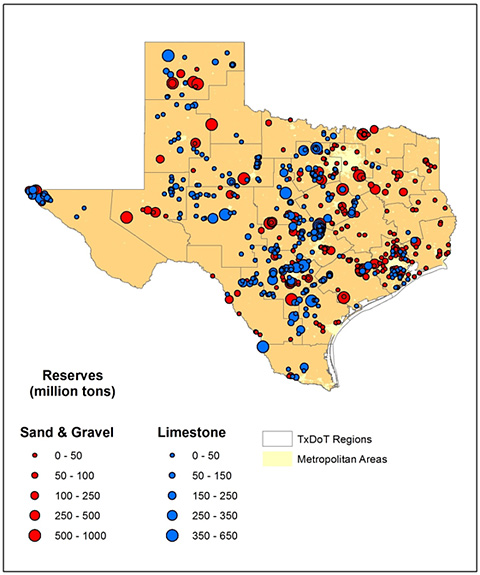
Location and volume of limestone and sand and gravel aggregate reserves in Texas.
Due to the current population growth and rapid urbanization, the use of construction materials has increased significantly. This recent boom in construction has also significantly increased the demand for aggregate. To meet the demand, new sources of aggregate are being explored and new aggregate quarries are being developed.
Aggregate is a mostly nonrenewable natural resource, but research is being conducted with an emphasis on using aggregates in a more sustainable manner. Recycled aggregates, industry waste, and new sources of aggregates are being used in the construction industry. However, alternate sources of aggregates represent only a small percentage of the total aggregate need. As a result, reserves of natural aggregates are being depleted rapidly in some areas of the state. According to the U.S. Geological Survey, 30% of aggregate is used for highway construction. Although natural aggregate sources are widely distributed throughout Texas, they are not universally suitable for consumption. In many cases the local aggregate sources do not meet the required organizational aggregate specifications (e.g. TxDOT requirements for different types of road construction). Rapid expansion of residential, industrial, and commercial areas and increasingly stringent environmental regulations have begun limiting aggregate mining, particularly in and around urban areas. In areas where acceptable quality aggregate is not locally available, it may become necessary to improve the quality of local aggregates, to import aggregates from outside sources, or to use artificial aggregates instead of local aggregates. Therefore, it is important for research to study these materials, how and where we use them, and develop policies for aggregate use and strategies for ensuring adequate future aggregate supplies. Where end use applications for aggregates overlap with the large Texas energy industry base, research collaborations exist with CEE and other Bureau programs for trends, activity and future developments.
Research topics include:
- Resource analysis
- Geologic mapping of aggregate resources
- Mapping geologic setting of the aggregate used in Texas (including surrounding states and Mexico)
- Quantifying aggregate reserve and overburden
- Calculating the volume and tonnage of aggregate reserve, calculate overburden volume that will be removed to extract the resource, create an economic mineral resource model showing economics of increasing depth, expanding horizontally, and permitting costs and restrictions for mining below the ground water level and near ground water bodies
- Mapping favorability for extraction
- Mapping proximity to end users, transportation infrastructure, metropolitan areas, and other characteristics like resource quality and stripping ratio to build a combined map of new favorable mining sites in Texas
- Application
- Identifying favorable locations for aggregate use (applied aggregate specifications)
- Mapping regions by aggregate specification and best usage principles
- Exploring the characteristics of aggregate for construction, concrete, pavement and other engineered materials
- Exploring the behavior of recycled and blended aggregate products for sustainability
- Logistics and transportation economics
- Evaluating favorable modes of transportation
- Creating network datasets for all modes of transportation infrastructure in Texas, modeling costs of transportation, and calculating optimum routes using one or more modes of transportation
- Identifying new infrastructure development opportunities
- Evaluating impact of new transport infrastructure like rail roads, highways, freight transfer stations etc. near mining sites and explore prospects and potential benefits for new infrastructure
- Other Industrial Minerals in Texas currently being researched:
- Sulfur
- Gypsum
- Cement
- Salt
- Caliche
- Clay
- Zeolites
- Dimension stone (granite, limestone, gabbro, etc.)
References
Kyle, J. R., 2018, Industrial Minerals of Texas: The University of Texas at Austin, Bureau of Economic Geology, State Map Series, SM0011.
Kyle, J. R., Elliott, B. A., 2019, Past, present, and future of Texas industrial minerals: Mining, Metallurgy & Exploration, v. 36, p. 475–486. doi.org/10.1007/s42461-019-0050-1.